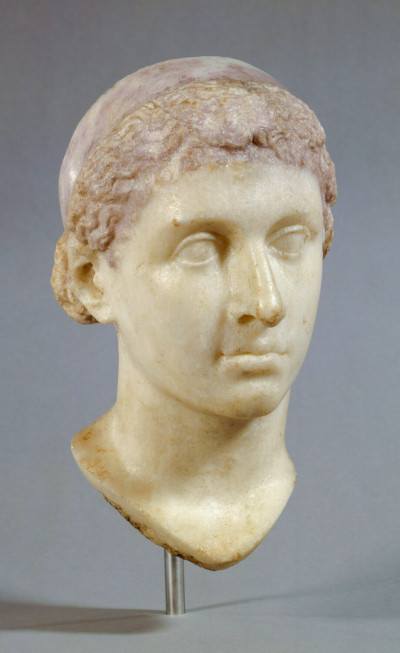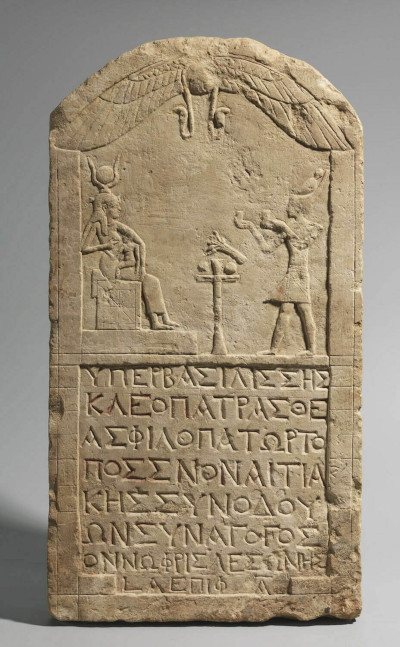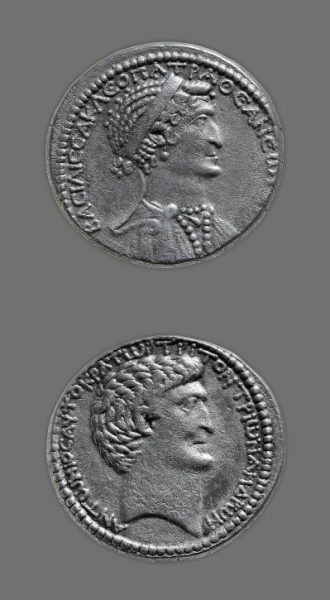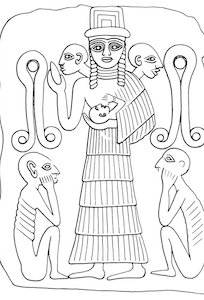
Not a Friend of ASOR yet? Sign up here to receive ANE Today in your inbox weekly!

February 2024
Vol. 12, No. 2
Cleopatra’s Languages
By Rolf Strootman
In Antiquity, Cleopatra VII, the last ruler of the Ptolemaic dynasty (ruled 51–30 BCE), was renowned for both her beauty and her intelligence. She also was a famous polyglot. In his Life of Marc Antony (27.2–4), the Greek historian Plutarch tells us that the legendary “Queen of the Nile” was able to speak “whatever language she pleased.” According to Plutarch, Cleopatra conversed with Ethiopians, Troglodytes, Hebrews, Arabians, Syrians, Medes, Parthians, “and many other peoples” without the assistance of an interpreter, and moreover was the first of her Greek-speaking dynasty to have mastered the Egyptian language.
The many languages that Cleopatra allegedly spoke are treated with skepticism in modern scholarship. Not because modern admirers doubt her intelligence, but because Plutarch’s list of languages looks a bit weird. Why on earth would she have bothered to learn Ethiopian, Parthian, let alone “Troglodytic”? Some have dismissed Cleopatra’s polyglotism as merely a hobby of hers, or as the result of the sophisticated education she had received in the famous Mouseion of cosmopolitan Alexandria. Others have suggested that she needed these languages to be able to negotiate with foreign ambassadors in private. But the diplomatic lingua franca of the so-called Hellenistic world was Greek. Furthermore, Cleopatra’s principal international interlocutors — Latin-speaking Romans — are conspicuously absent from the list.
Here I offer a new understanding of Cleopatra’s linguistic proficiency from the perspective of imperial rhetoric and court ceremonial. The central theses are (1) that Cleopatra spoke these languages in a ritualized, public context; and (2) that the languages listed by Plutarch can be “read” as an outline of the Ptolemaic Empire, consisting of the territories over which the Ptolemies for centuries had exercised hegemony plus the Iranian territories of the former Seleukid Empire that Cleopatra VII claimed in addition. This interpretation challenges the popular understanding of the Ptolemaic Empire as a kind of modern, European-style nation-state that was geographically restricted more or less to what we know as “Egypt”. I also argue that listing peoples and using a variety of languages in royal representation has older Near Eastern roots. By reinterpreting Cleopatra’s language-speaking as a form of imperial rhetoric, it can furthermore be shown that Africa beyond Egypt held a more important place in the Ptolemaic concept of empire than normally claimed.
Making Sense of Cleopatra’s Multilingualism
If we look carefully at the list of peoples with whom Cleopatra was able to communicate in their own respective languages, it immediately becomes clear that these people were not randomly chosen. They can be located on an uninterrupted geographical continuum stretching from the Sudan and the Horn of Africa through Egypt to Iran.
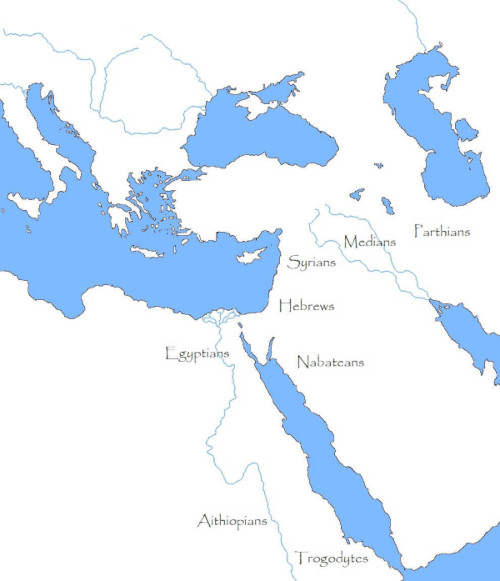
The first group Plutarch mentions are the Ethiopians, “the [people with] burnt faces”, which is the Greek designation for the populations of the Upper Nile valley south of Egypt (ancient Nubia and Kush, both not to be confused with present-day Ethiopia). In addition, the land of the Ethiopians can be a mythical, utopian land in Greek mythology, located on the (Indian) Ocean, “at the farthest limits of mankind” as we read in the Odyssey (1.22). Both meanings — Ethiopians as a mythical people living on the edge of the earth and as the historical people inhabiting Upper Nilotic Africa — are relevant for understanding Cleopatra’s multilingualism. Next in Plutarch’s list are the “Troglodytes” (sometimes spelled Trogodytes), the Greek umbrella term for pastoralist groups living in the Eastern Desert between the Nile and the Red Sea. The Egyptians, too, are included when Plutarch writes that Cleopatra was the first of her dynasty to have learned their language. The African peoples on the list — Ethiopians, Troglodytes, Egyptians — thus represent the three main African regions within the Ptolemaic sphere of influence: Egypt, the Nile region south of Egypt, and the African Red Sea coast.
The journey continues to the Red Sea’s Arabian hinterland and the Levant, represented by the “Arabians”, “Hebrews”, and “Syrians”. Finally, the “Medes” and “Parthians” represent the Armenian highlands and the Iranian plateau. As was the case with African peoples on the list, these peoples together represent regions that were central to the empires of Alexander the Great and his successors: (1) the Aramaic-speaking Near East and (2) the Iranian-speaking so-called Upper Satrapies.
The Ritual Context
Plutarch strongly suggests Cleopatra spoke her languages in a ritual context: a public audience perhaps in which she conversed with (or welcomed) envoys in their own native tongues, comparable to the multilingual blessings pronounced by the Pope at the two-yearly Urbi et Orbi address. There is no hint of secret negotiations behind closed doors; instead, Plutarch emphasizes the theatricality of Cleopatra’s appearance and the impression it made on audiences.
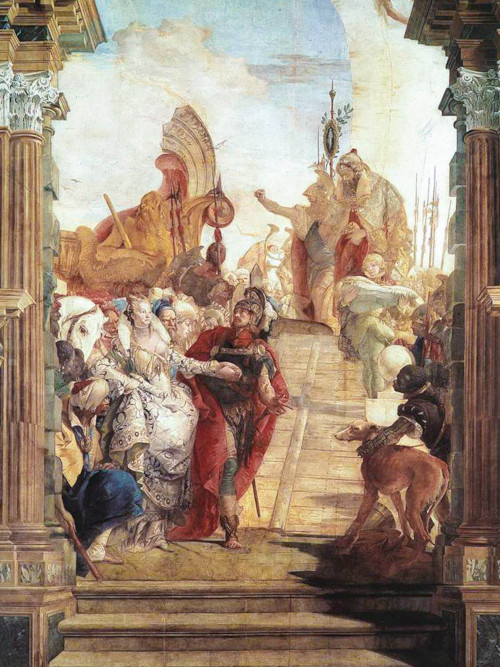
The historical context of the passage, too, points in the direction of a public court ritual. The passage is inserted immediately after Plutarch’s account of the meeting of Cleopatra and Antony at Tarsus in 41 BCE — a carefully orchestrated performance that first conveyed to the world their alliance and their imperial ambitions. These celebrations were followed by two more theatrical events with “international” allure. The first was a New Year festival celebrated by Cleopatra and Antony at Antioch in Syria in 37/6 BCE to inaugurate a new, everlasting Imperial Era of peace and prosperity; at this occasion, Antony gave Cleopatra partial control of the Levant, Libya, Cyprus, and Crete. The second royal ceremonial was the so-called Donations of Alexandria in 34 BCE, when Cleopatra adopted the imperial title Queen of Kings while her son with Caesar, Ptolemy XV (Caesarion, at that time still a minor), became King of Kings. Relatively detailed descriptions survive of the lands over which Cleopatra, with the consent of Antony, claimed suzerainty. The Roman historian Cassius Dio lists Egypt and Cyprus; Syria (i.e., the Levant) “and the whole region to the west of the Euphrates as far as the Hellespont”; Cyrenaica in Libya; and “the other lands east of the Euphrates as far as India.” Plutarch provides a comparable overview, and for the regions east of Euphrates specifies “Armenia, Media and Parthia as soon as [Antony] would have conquered it.” Cleopatra’s three children with Antony were to become viceroys of these regions.
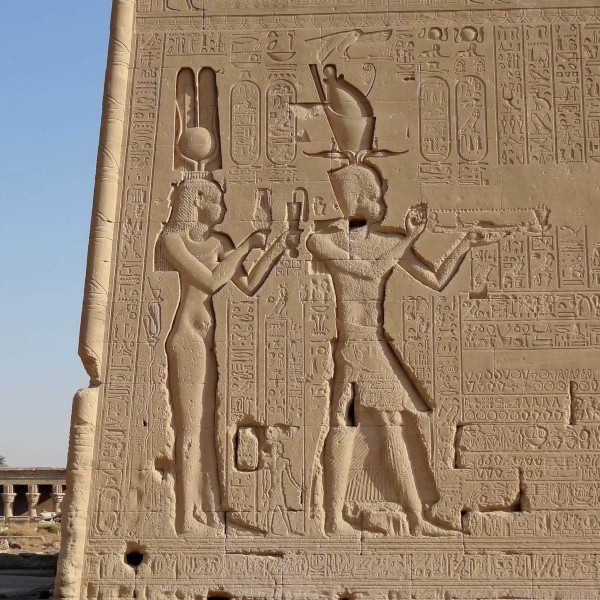
This is a huge empire, comprising the entire former Ptolemaic and Seleucid empires as these had existed in the third century BCE. These claims thus shed a different light on Cleopatra’s political ambitions as compared to the usual view that her aim was only to protect the independence of Egypt. Cleopatra’s role in world history is far more important than that: she was the central figure in the Roman reorganization of the East. There is a close equivalence between the lands claimed by Cleopatra at the Donations of Alexandria and the list of peoples whose languages Cleopatra spoke. The main difference is the inclusion in the latter of East Africa, a region where direct Roman influence cannot easily be assumed.
Countries, Peoples, and Languages
Similar images of empire can be seen in earlier Ptolemaic texts, for example the Adulis Stele, an official account of “the Great King” Ptolemy III’s exploits during the Third Syrian War (246–241). Set up near the mouth of the Red Sea in present-day Eritrea, the inscription first lists the lands that Ptolemy had inherited upon his accession — Egypt, Libya, Syria, Phoenicia, Cyprus, Lycia, Caria, and the Cyclades — and then the conquests he himself claimed to have made: after conquering the Levant, “he crossed the river Euphrates and subdued Mesopotamia, Babylonia, Susiana, Persis, Media and the rest of the land as far as Baktria (Afghanistan).” The inscription moreover says that Ptolemy gathered war elephants from India and “from the land of the Troglodytes and Ethiopia.” Though the conquests (at the expense of the Seleukids) in the Middle East were impermanent and partly imaginary, the imperial view expressed by the Adulis Stele is immediately reminiscent of the list of peoples in the Life of Antony.
Though listing countries rather than peoples, the Adulis Stele stands in a tradition of Near Eastern texts in which the world empire is described through a detailed ethnographic catalog. The best-known example is the inscription of Darius I at Bīsotūn (Behistun) from c. 520 BCE, summing up no less than twenty-three peoples. The Persian Empire is thereby imagined as a commonwealth of peoples — an image that is also visually conveyed through the tribute-bearer reliefs at Persepolis.
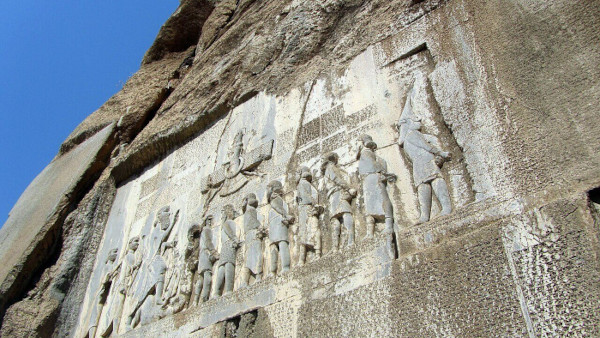
Achaemenid imperial inscriptions are multilingual, being composed in Persian, Elamite, and Babylonian (in cuneiform script). Languages are sometimes explicitly referred to. On the Terrace Inscription at Persepolis, Darius I describes the extent of his empire as “Persia, Media, and the other lands with other tongues”; and on Darius’ tomb at Naqš-e Rōstam we read: “I am Darius, the Great King, the King of Kings, the king of all languages.” Royal multilingualism persisted in the Hellenistic period, as is shown by the trilingual steles from Egypt such as the Canopus Decree or the Rosetta Stone, and the Greek-Aramaic Seleukid inscriptions preserved at Pasargadai and Bīsotūn.
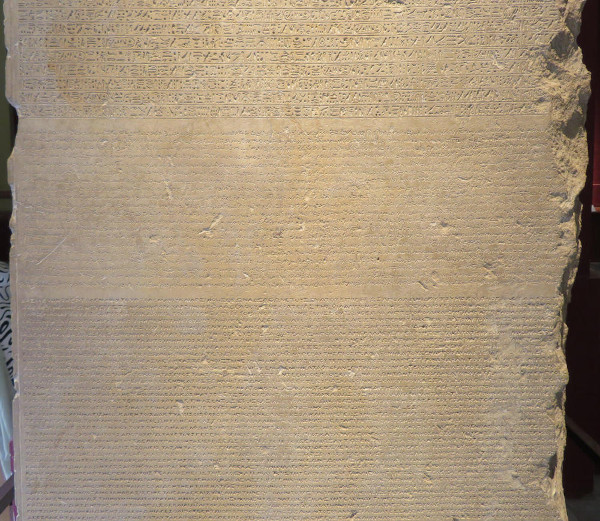
That by the Hellenistic period, if not earlier, different languages were actually spoken by monarchs is shown by the case of another Hellenistic ruler and empire-builder, king Mithradates VI of Pontus, one generation before Cleopatra. Several sources say that Mithradates spoke a staggering twenty-two languages. Pliny explicitly writes that these were the languages “of the numerous nations that were subject to him” (Natural History 25.3.6).
In sum, the languages spoken by Cleopatra can be understood as a description of her (imagined) empire, consisting of regions formerly under Ptolemaic hegemony plus the Upper Satrapies that Antony hoped to take from the Parthians and Cleopatra could rightfully claim as the heir of the Seleucid dynasty. Cleopatra followed an older Near Eastern tradition of summing up the peoples that constitute the empire, emphasizing the most faraway lands. Latin is conspicuously absent from Plutarch’s list because Cleopatra never expressed the intention to rule the Romans. An important conclusion to be drawn from Plutarch’s list is that in Cleopatra’s imperial vision, African populations to the south and east of Egypt featured prominently — something that both modern historians and our Mediterranean-focused narrative sources are usually not very interested in.
Rolf Strootman lectures in Ancient History and World History at Utrecht University in the Netherlands. His article, “Cleopatra’s veeltaligheid” (“Cleopatra’s Languages”) was recently published in the journal Lampas (in Dutch).
Further Reading and Sources:
Jacobs, B. 2012. Sprachen, die der König spricht. Zum ideologischen Hintergrund der Mehrsprachigkeit der Achämenideninschriften. In R. Rollinger et al. (eds.): Altertum und Gegenwart: 125 Jahre Alte Geschichte in Innsbruck. Innsbruck, 95–130.
Strootman, R. 2010. Queen of Kings: Cleopatra VII and the Donations of Alexandria. In M. Facella and T. Kaizer (eds.): Kingdoms and Principalities in the Roman Near East. Stuttgart, 139–158.
Strootman, R. 2023. Cleopatra’s veeltaligheid. Lampas 56.2: 153–175.
How to cite this page:
Strootman, R. 2024. Cleopatra’s Languages. The Ancient Near East Today 12.2. Accessed at: www.asor.org/anetoday/2024/02/cleopatras-languages.
Want To Learn More?
Gender in the Ancient Near East and Egypt
By Stephanie Budin
Sex and gender have become central topics of discussion in a wide variety of fields. What did the people of ancient Mesopotamia and Egypt think about these concepts? Read More
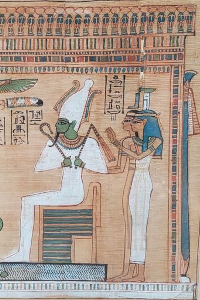 The Egyptian Conceptualization of the Otherworld
The Egyptian Conceptualization of the Otherworld
By Silvia Zago
As the place where the deceased continued living after death, the Duat is a core notion of Egyptian afterlife beliefs. But pinning down its features and location is no easy feat. Read More
